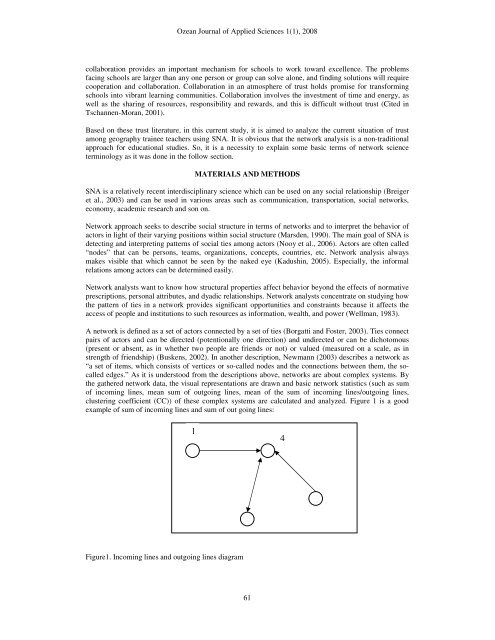Journal of Applied Science Studies - Ozean Publications
Journal of Applied Science Studies - Ozean Publications
Journal of Applied Science Studies - Ozean Publications
You also want an ePaper? Increase the reach of your titles
YUMPU automatically turns print PDFs into web optimized ePapers that Google loves.
<strong>Ozean</strong> <strong>Journal</strong> <strong>of</strong> <strong>Applied</strong> <strong>Science</strong>s 1(1), 2008<br />
collaboration provides an important mechanism for schools to work toward excellence. The problems<br />
facing schools are larger than any one person or group can solve alone, and finding solutions will require<br />
cooperation and collaboration. Collaboration in an atmosphere <strong>of</strong> trust holds promise for transforming<br />
schools into vibrant learning communities. Collaboration involves the investment <strong>of</strong> time and energy, as<br />
well as the sharing <strong>of</strong> resources, responsibility and rewards, and this is difficult without trust (Cited in<br />
Tschannen-Moran, 2001).<br />
Based on these trust literature, in this current study, it is aimed to analyze the current situation <strong>of</strong> trust<br />
among geography trainee teachers using SNA. It is obvious that the network analysis is a non-traditional<br />
approach for educational studies. So, it is a necessity to explain some basic terms <strong>of</strong> network science<br />
terminology as it was done in the follow section.<br />
MATERIALS AND METHODS<br />
SNA is a relatively recent interdisciplinary science which can be used on any social relationship (Breiger<br />
et al., 2003) and can be used in various areas such as communication, transportation, social networks,<br />
economy, academic research and son on.<br />
Network approach seeks to describe social structure in terms <strong>of</strong> networks and to interpret the behavior <strong>of</strong><br />
actors in light <strong>of</strong> their varying positions within social structure (Marsden, 1990). The main goal <strong>of</strong> SNA is<br />
detecting and interpreting patterns <strong>of</strong> social ties among actors (Nooy et al., 2006). Actors are <strong>of</strong>ten called<br />
“nodes” that can be persons, teams, organizations, concepts, countries, etc. Network analysis always<br />
makes visible that which cannot be seen by the naked eye (Kadushin, 2005). Especially, the informal<br />
relations among actors can be determined easily.<br />
Network analysts want to know how structural properties affect behavior beyond the effects <strong>of</strong> normative<br />
prescriptions, personal attributes, and dyadic relationships. Network analysts concentrate on studying how<br />
the pattern <strong>of</strong> ties in a network provides significant opportunities and constraints because it affects the<br />
access <strong>of</strong> people and institutions to such resources as information, wealth, and power (Wellman, 1983).<br />
A network is defined as a set <strong>of</strong> actors connected by a set <strong>of</strong> ties (Borgatti and Foster, 2003). Ties connect<br />
pairs <strong>of</strong> actors and can be directed (potentionally one direction) and undirected or can be dichotomous<br />
(present or absent, as in whether two people are friends or not) or valued (measured on a scale, as in<br />
strength <strong>of</strong> friendship) (Buskens, 2002). In another description, Newmann (2003) describes a network as<br />
“a set <strong>of</strong> items, which consists <strong>of</strong> vertices or so-called nodes and the connections between them, the socalled<br />
edges.” As it is understood from the descriptions above, networks are about complex systems. By<br />
the gathered network data, the visual representations are drawn and basic network statistics (such as sum<br />
<strong>of</strong> incoming lines, mean sum <strong>of</strong> outgoing lines, mean <strong>of</strong> the sum <strong>of</strong> incoming lines/outgoing lines,<br />
clustering coefficient (CC)) <strong>of</strong> these complex systems are calculated and analyzed. Figure 1 is a good<br />
example <strong>of</strong> sum <strong>of</strong> incoming lines and sum <strong>of</strong> out going lines:<br />
1<br />
4<br />
Figure1. Incoming lines and outgoing lines diagram<br />
61

















